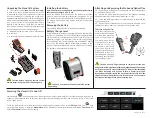
5 Troubleshooting PVA Operation
5-6
This type of trace may be seen if you have been measuring strings or modules with a
certain level of current and voltage, and then switch to measuring PV sources that have
much higher or lower currents or voltages. The solution is to re-take the measurement.
This is normal behavior under such circumstances because the PV Analyzer
automatically reconfigures its circuitry for best measurement accuracy, and to save
measurement time, it bases this reconfiguration decision on the previous measurement
result.
This symptom may also occur in the first measurement made after starting the PVA
software. This is due to the fact that the PVA did not have a prior measurement on which
to base its automatic optimization of its internal circuit settings. Simply take a new curve.
I-V trace consists of straight line segments
This is normally a result of the PVA software not having a prior I-V curve upon which to
base the optimization of internal circuits. Just re-take the measurement and the I-V curve
will be normal.
Trace is noisy
Noisy I-V curve traces may be a result of low irradiance, especially for PV technologies
with very low short circuit current. For best results, perform measurements of fixed
arrays during the hours of maximum irradiance. Strings of low I
sc
modules can be tested
in parallel to increase current and reduce noise.
I-V curve drops to zero current at one or more points
This can occur if there is an unstable electrical connection in the PV circuit being
measured. This is not a problem with the I-V Measurement Unit. In stages, remove
modules and cables from the PV source circuit to locate the unstable connection.
Short circuit current is much higher, or lower, than predicted by the model
Verify that the irradiance sensor is mounted in the plane of the array. Check for array
soiling. Check that the latitude, longitude, and azimuth are correctly entered in the Site
Info screen, and that the computer date and time are correct.
Unstable voltage message
Before performing a sweep, the PVA measures V
oc
10 times to get an average value. If
there is a large variation of values across these 10 measurements, the software posts a
warning. Check for poor connections anywhere in the measurement loop.
I-V Measurement Unit cannot be turned on
Check that the Unit has been charged.
Thermal fuse
The I-V Measurement Unit contains a thermal fuse set to trip at 85C. This is an
uncommon occurrence, but it irreversibly shuts down the Unit. If you suspect that this has
occurred, contact Solmetric Technical Support.
Summary of Contents for PVA-1000S
Page 12: ...xii This page is intentionally left blank ...
Page 68: ...1 Getting Started 2 56 Over Voltage Warnings ...
Page 116: ......
Page 128: ......
Page 133: ...7 Interpreting Measured I V Curves 7 5 5 4 Rounder knee 6 ...
Page 148: ......
















































